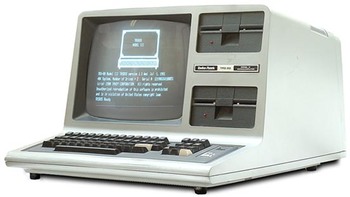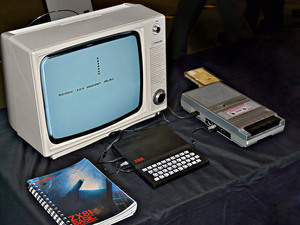When I first got a job in computing we worked on a computer like this one.

The system which ran a manufacturing company of some 700 employees had a CPU with 64K of memory which took up the space of small van. It had four disk drives, each about the size of a washing machine, on which you could load removeable disks like a pile of 6 oversized pizzas (about 2 foot across). Programming was done on punched cards, (usually between 2000 and 9000 cards per program step, with 18 programs to run a payroll.)
Windows or other multiprocessing systems had yet to arrive. The 360 could run a staggering 1 process concurrently.
There were no screens. An operator would run the programs via a console consisting of an entry keyboard and a typewriter. (Think of the teletype on which the Grandstand football results used to come up). Error messages were restricted to 3 characters to save time. ("%14" for instance meant an employee who is no longer employed has been included in this pay run.)
The operators main job apart from monitoring these messages was swapping the disks after each program step.
A typical payroll run took over an hour to complete.
A cost analysis for the week, (run just after midnight on Wednesdays) took 3 1/2 hours.)
There was a big red emergency pull switch on the front, which was to be pulled if ever the CPU caught fire, which, happily, it never did. New staff were "initiated" by getting them to unscew said switch and screw it back on with a coke can tab hanging behind the red bit, without killing the system. (It would take half a day to reboot.)

Ah! Simpler times.
The system which ran a manufacturing company of some 700 employees had a CPU with 64K of memory which took up the space of small van. It had four disk drives, each about the size of a washing machine, on which you could load removeable disks like a pile of 6 oversized pizzas (about 2 foot across). Programming was done on punched cards, (usually between 2000 and 9000 cards per program step, with 18 programs to run a payroll.)
Windows or other multiprocessing systems had yet to arrive. The 360 could run a staggering 1 process concurrently.
There were no screens. An operator would run the programs via a console consisting of an entry keyboard and a typewriter. (Think of the teletype on which the Grandstand football results used to come up). Error messages were restricted to 3 characters to save time. ("%14" for instance meant an employee who is no longer employed has been included in this pay run.)
The operators main job apart from monitoring these messages was swapping the disks after each program step.
A typical payroll run took over an hour to complete.
A cost analysis for the week, (run just after midnight on Wednesdays) took 3 1/2 hours.)
There was a big red emergency pull switch on the front, which was to be pulled if ever the CPU caught fire, which, happily, it never did. New staff were "initiated" by getting them to unscew said switch and screw it back on with a coke can tab hanging behind the red bit, without killing the system. (It would take half a day to reboot.)
Ah! Simpler times.




